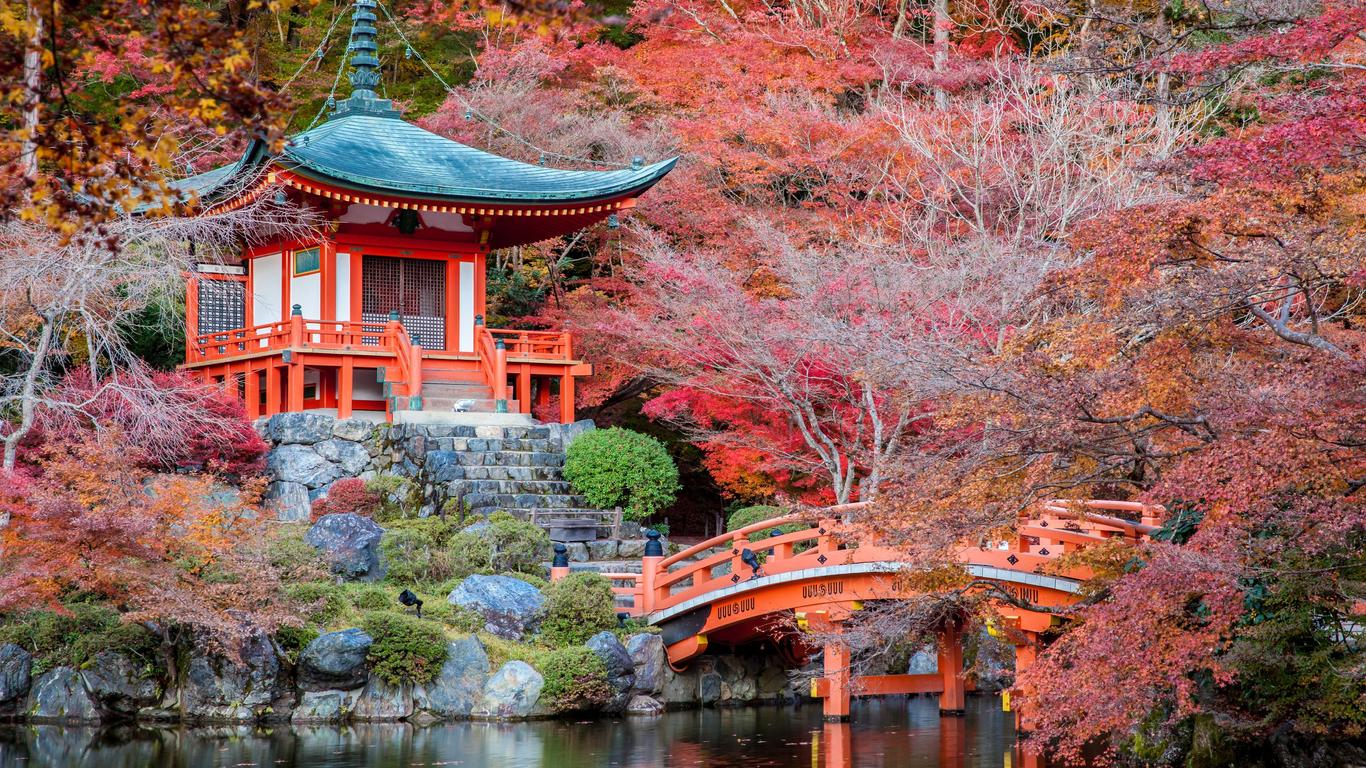
Nestled amidst the picturesque landscapes of Japan, Kyoto emerges as a city where the ancient gracefully intertwines with the contemporary. With roots reaching back to the Heian period, Kyoto stands as a living testament to Japan’s rich history, cultural legacy, and spiritual depth. From the imperial splendor of its palaces to the tranquility of its bamboo groves, each corner of Kyoto tells a story, inviting visitors to embark on a journey through time. In this exploration, we unravel 25 historical facts and captivating details, showcasing Kyoto’s role as a cradle of tradition, a beacon of innovation, and a timeless destination where the past and present coexist in harmony. Join us as we delve into the essence of Kyoto, a city that embodies the very soul of Japan.
Foundation Year: Kyoto, Japan, was founded in 794 by Emperor Kammu during the Heian period, marking the initiation of a cultural and political era that would significantly influence Japanese history. The city’s establishment as the imperial capital was a strategic move to escape the growing influence of Buddhist monasteries in Nara and create a new center for political power and cultural development.
Historical Monuments: With 17 UNESCO World Heritage Sites, Kyoto stands as a living testament to Japan’s rich cultural and historical tapestry. The Kinkaku-ji (Golden Pavilion) showcases the opulence of the Ashikaga shoguns, while the Gion District preserves the traditional wooden machiya houses, immersing visitors in the ambiance of historical Japan. Kiyomizu-dera, with its wooden terrace offering panoramic views, exemplifies Kyoto’s harmonious integration of nature and architecture.
Emperor’s Residence: The Kyoto Imperial Palace served as the imperial family’s official residence for centuries until the capital moved to Tokyo in 1869. Nestled within the Kyoto Imperial Park, this palace provides a glimpse into Japan’s imperial history, with meticulously maintained gardens and architectural structures reflecting the elegance of the Heian period.
Geisha District: Gion, Kyoto’s renowned geisha district, is a cultural treasure trove where traditional wooden machiya houses transport visitors back in time. Geishas, synonymous with Kyoto’s cultural identity, continue to practice their refined arts in Gion, making it a living testament to the city’s commitment to preserving its historical legacy.
Kyoto Protocol: The Kyoto Protocol, adopted in 1997, was a pivotal moment in global efforts to address climate change. Named after the city where the treaty was negotiated, it set binding emission reduction targets for developed nations, emphasizing Kyoto’s role not only in Japan’s history but also in shaping global environmental policy.
Population: With a population exceeding 1.4 million, Kyoto is a vibrant metropolis that seamlessly balances modernity with tradition. Its dynamic population contributes to the city’s ongoing evolution, ensuring that Kyoto remains a cultural hub and a beacon of historical significance in contemporary Japan.
Former Capital: For over a millennium, Kyoto was Japan’s imperial capital, witnessing the rise and fall of shogunates, the influence of samurais, and the cultural flourishing of the Heian period. The legacy of being the heart of Japanese governance and culture is palpable in every corner of this city.
Zen Buddhism: Home to significant Zen Buddhist temples like Daitoku-ji and Tofuku-ji, Kyoto is a spiritual center where the teachings of Zen have thrived. These temples, with their serene gardens and contemplative spaces, continue to attract seekers of enlightenment, contributing to Kyoto’s role as a sanctuary for spiritual reflection.
Kyoto Cuisine: Kyoto’s Kaiseki cuisine reflects the city’s commitment to preserving culinary traditions. This multi-course dining experience highlights seasonal ingredients, presenting a culinary journey that mirrors Kyoto’s appreciation for the beauty of nature and its changing seasons.
Kyoto University: Established in 1897, Kyoto University has been a beacon of academic excellence, producing Nobel laureates and contributing significantly to scientific research and advancements. The university’s impact extends beyond Japan, solidifying Kyoto’s position as an intellectual hub in the global academic community.
Kyoto’s Elevation: With an average elevation of approximately 300 meters (984 feet) above sea level, Kyoto enjoys a unique topography that offers stunning views of the surrounding mountains and landscapes. This elevation contributes to the city’s picturesque setting, providing residents and visitors alike with a visually captivating environment.
Cherry Blossom Season: Kyoto’s fame during the Hanami season, when cherry blossoms bloom in spring, draws crowds from around the world. The delicate pink and white blossoms create a breathtaking spectacle, and the tradition of Hanami, or flower viewing, is deeply ingrained in Kyoto’s cultural identity, symbolizing the transient beauty of life.
Kyoto’s Geographical Area: Encompassing approximately 827 square kilometers (319 square miles), Kyoto ranks among Japan’s larger cities in terms of land area. This expansive space allows for a diverse range of landscapes, from bustling urban districts to serene countryside retreats, contributing to the city’s multifaceted charm.
Kyoto Tower: Soaring to a height of 131 meters (430 feet), Kyoto Tower stands as a prominent landmark in the city. Offering panoramic views of Kyoto and its surroundings from its observation deck, the tower provides a modern contrast to Kyoto’s traditional architecture, symbolizing the city’s harmonious blend of the old and the new.
Kyoto Municipal Museum of Art: Designed by architect Kunio Maekawa and opened in 1933, the Kyoto Municipal Museum of Art is a cultural gem that houses a diverse collection of traditional and contemporary Japanese art. This institution serves as a testament to Kyoto’s commitment to fostering artistic expression and preserving its rich cultural heritage.
Kyoto’s Philosopher’s Path: Known as Tetsugaku no Michi, the Philosopher’s Path is a scenic walkway along a canal lined with hundreds of cherry trees. Named after the philosopher Nishida Kitaro, who is said to have used the path for daily meditation, the route encapsulates the beauty of Kyoto’s natural surroundings and serves as a tranquil retreat for contemplation.
Kyoto’s Nijo Castle: Constructed in 1603, Nijo Castle is a cultural treasure with a unique feature known as the “nightingale floors.” These floors emit a distinctive chirping sound when walked upon, serving as a built-in security system to alert occupants to the presence of potential intruders, reflecting the architectural ingenuity of the time.
Kyoto Railway Museum: Opened in 2016, the Kyoto Railway Museum is a testament to Japan’s innovation in transportation. Featuring a vast collection of vintage locomotives and railway memorabilia, the museum showcases Kyoto’s commitment to preserving its industrial heritage and technological advancements.
Kyoto’s Modern Architecture: While Kyoto is renowned for its historical architecture, it embraces modern design as well. The Kyoto International Conference Center, designed by architect Sachio Otani, exemplifies contemporary architecture in the city, reflecting Kyoto’s ability to integrate tradition with modernity.
Kyoto’s Ginkaku-ji: Commonly known as the Silver Pavilion, Ginkaku-ji, constructed in 1482, represents the pinnacle of Japanese aesthetics. Though it was never coated in silver as originally planned, the temple is celebrated for its beautiful gardens and serene atmosphere, exemplifying Kyoto’s commitment to preserving and showcasing its cultural treasures.
Kyoto’s Bamboo Grove: Situated in the Arashiyama district, Kyoto’s Bamboo Grove is a natural wonder that captivates visitors with its towering bamboo shoots. This enchanting grove creates a surreal atmosphere, transporting individuals into a world of tranquility and natural beauty. The rustling bamboo leaves and dappled sunlight contribute to an otherworldly experience, making this grove a must-visit destination in Kyoto.
Kyoto’s Fushimi Inari Shrine: Dedicated to the Shinto god of rice, Fushimi Inari Shrine is an iconic symbol of Kyoto. What sets it apart is the mesmerizing pathway lined with thousands of vermillion torii gates, creating a vibrant tunnel leading to the sacred Mount Inari. This shrine, with its spiritual significance and visually stunning landscape, reflects Kyoto’s deep connection to its religious and cultural heritage.
Kyoto’s Tea Culture: Kyoto’s association with traditional Japanese tea ceremonies is deeply ingrained in its cultural fabric. Uji, a city just south of Kyoto, is renowned for producing high-quality green tea, and Kyoto’s tea culture reflects a refined appreciation for the artistry and ritual associated with tea preparation. This cultural aspect not only enriches the daily lives of Kyoto’s residents but also contributes to the city’s global identity.
Kyoto’s Ginkaku-ji Moss Garden: Ginkaku-ji’s meticulously maintained moss garden is an exquisite example of traditional Japanese landscaping. The careful arrangement of moss, stones, and trees creates a peaceful and harmonious environment, embodying Kyoto’s dedication to preserving and showcasing the aesthetic principles that have defined Japanese gardens for centuries.
Kyoto’s Kitano Tenmangu Shrine: Established in 947 and dedicated to Sugawara no Michizane, a scholar and politician, Kitano Tenmangu Shrine is a cultural and spiritual focal point in Kyoto. The shrine’s monthly Tenjin-san Flea Market, held on the 25th of each month, adds a vibrant touch to Kyoto’s cultural scene, attracting visitors in search of antiques and local crafts. This market, along with the shrine’s historical significance, exemplifies Kyoto’s commitment to fostering a rich and diverse cultural tapestry.









